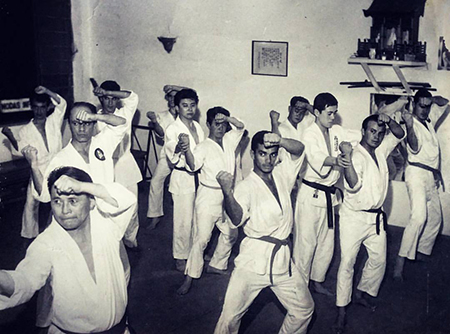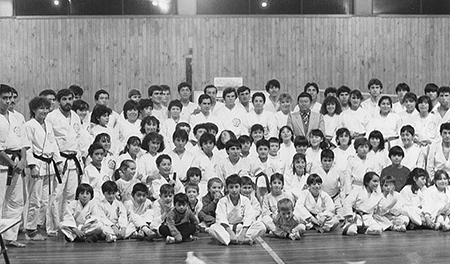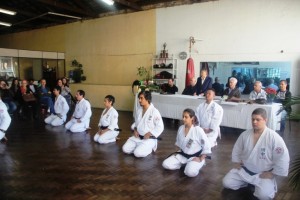Karate-Do is a martial art from the island of Okinawa, Japan. The techniques that came to make up modern Karate originated from several sources, including a mixture of native fighting styles from the Okinawan people with Kung Fu practiced in southern China. The eclecticism of the art had as its main objective to bring together efficient and direct self-defense techniques, because the inhabitants of the island were forbidden to use weapons for centuries, so they developed forms of unarmed combat or with unconventional instruments such as oars, for example.

For many years, Karate grew and developed in a veiled, almost secret manner. There were no dojos and the masters passed on their knowledge to a few students. This changed after Japan annexed Okinawa, which had previously been an independent kingdom. At the end of the 19th century, efforts began to be made to promote Karate more widely and to introduce it into schools.
The milestone for the modernization and subsequent popularization of Karate occurred when master Gichin Funakoshi, founder of Shotokan, went to Tokyo in 1921. There he began to spread Karate so that the art could spread throughout the world, an example followed by other contemporary masters. Years before, Funakoshi had already demonstrated the Okinawan art to Japanese authorities, who were quite impressed.
At this point, Karate was not yet a systematized art. There was no defined progression or standard uniform. As part of the modernization process, Karate borrowed the uniform and grading system used in Judo, with kyu and dan being used to differentiate the level of practitioners.
Another fact that marked the emergence of modern Karate was the emphasis that began to be placed on the practice of the art for the personal and moral development of the practitioner. Karate, in addition to being a fighting system, consolidated itself as a philosophy focused on moral formation, for the development of warriors for life. It was in this context that the art gained the “Do” (path/way) in its name and began to be called “Karate-Do”, which means “way of the empty hands”. Karate-Do uses the ethical principles of budo, a code that originated in the culture of the samurai.
Who can do Karate?

Karate-Do is an art that can be practiced by both men and women. At the Tanaka Karate-Do Association, training is recommended for children aged 6 and older and adults of any age. This is because the method can be adapted to different types of people and has very clear advantages to offer to practitioners. If the person is fit to perform physical activities, there are no major restrictions on starting to train.
If in doubt, get a medical evaluation to make sure there are no restrictions on training.
Other than that, it is important to remember that Karate values disciplined, sincere and respectful people. Training strengthens all of these values, among others. The right mindset helps you to fully enjoy the classes and enables growth.
What are the training sessions like?
Basic Karate-Do training consists of three main elements:

Kihon: this is the part where the fundamentals of the art are practiced, such as punches, kicks and defenses. It is like learning the alphabet of the art. In kihon, the techniques are presented and developed one by one.
Kata: this is the practice of formal Karate movements and the most traditional type of training in the art. Katas are pre-defined sequences of various techniques, which can be performed either individually or in a group. In addition to being an excellent physical activity, kata contains the strategies and movements used in self-defense.
Kumite: this is the application of Karate techniques with a partner. There are several types of kumite, from pre-arranged attack and defense sequences to fighting in its freer and more competitive format.
What benefits does Karate-Do provide?
Karate-Do is an activity that moves the entire body and is an excellent physical exercise. With regular practice, it is possible to overcome mobility problems, lose weight and tone the upper and lower limbs. As it is an aerobic exercise, Karate helps the blood to circulate and carry oxygen throughout the body, improving the functioning of the organism.

Karate also has several psychological benefits. Discipline, focus, self-confidence and tranquility are just some of these advantages. In addition, its philosophy values respect and consideration for others, values that are necessary for any citizen.
Another very clear benefit of Karate-Do is that it is a form of self-defense, a skill that is necessary at any time. Karate was developed from the beginning as an art to preserve the physical integrity of the practitioner. With Karate training, one develops techniques and the correct mentality to defend oneself.
The benefits of Karate-Do can be felt in several areas of life. A dedicated practitioner will feel that their ability to deal with people and everyday problems will improve considerably. This is because Karate works on analytical and interpersonal skills, in addition to the confident posture of a warrior and the psychological balance necessary to act more assertively in various situations.




